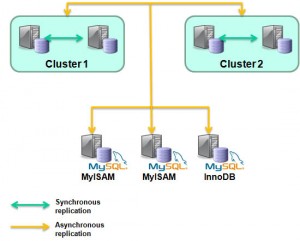One of the better kept secrets about MySQL Cluster appears to be the flexibility available when setting up replication. Rather than being constrained to implementing a single replication scheme, you can mix and match approaches.
Just about every Cluster deployment will use synchronous replication between the data nodes within a node group to implement High Availability (HA) by making sure that at the point a transaction is committed, the new data is stored in at least 2 physical hosts. Given that MySQL Cluster is usually used to store the data in main memory rather than on disk, this is pretty much mandatory (note that the data changes are still written to disk but that’s done asynchronously to avoid slowing down the database).

MySQL asynchronous replication is often used for MySQL Cluster deployments in order to provide Geographic Redundancy. At the same time as the synchronous replication within a Cluster, the changes can be replicated asynchronously to a second Cluster (or to more than one) at a remote location. Asynchronous rather than synchronous replication is used so that the transaction commit is not delayed while waiting for the remote (could be thousands of miles away, connected by a high latency WAN) Cluster to receive, apply and acknowledge the change. A common misconception is that changes being made through the NDB API will not be replicated to the remote site as this replication is handled by a MySQL Server instance – the reality is that the MySQL Replication implementation will pick up the changes even when they’re written directly to the data nodes through the NDB API.
A third use of replication is to store the Cluster’s data in a seperate database – for example to have a read-only, up-to-date copy of the data stored within the MyISAM storage engine so that complex reports can be generated from it. And the best news is that this can be done at the same time as the local HA and remote Geographic Redundancy replication!
Johan’s Blog provides the technical details around configuring replication in order to provide some extra scaling by setting up non-Cluster slave databases that pick up all changes from the Cluster database.